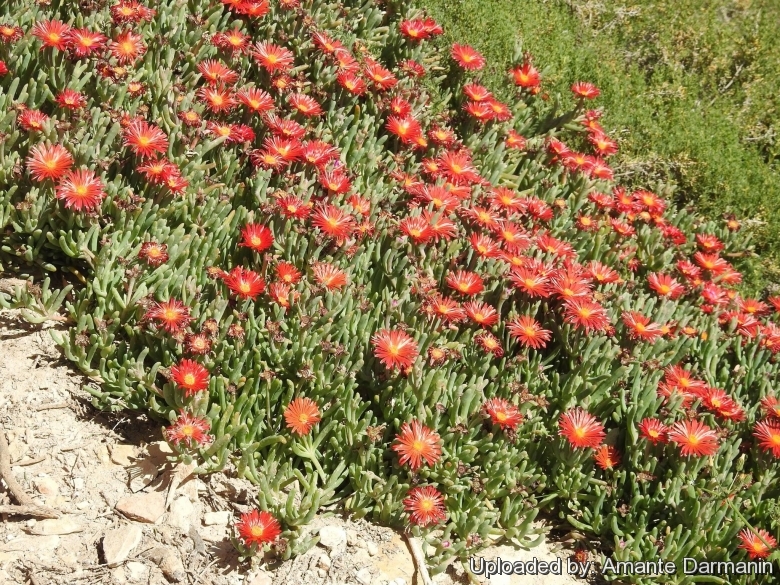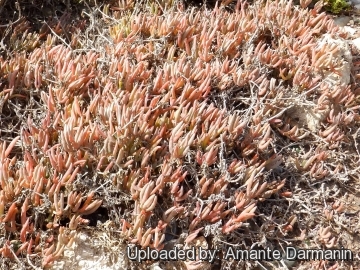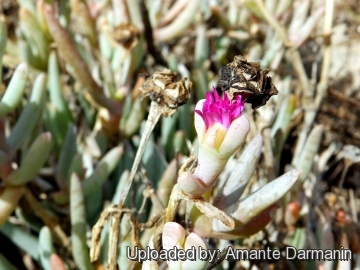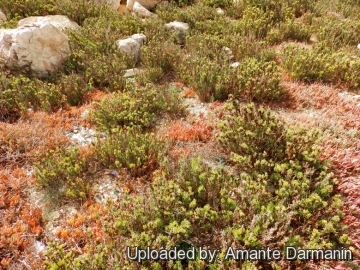




Your support is critical to our success.

Malephora crocea, Red ice-plant, Peter's pool, Delimara, Malta.10-03-2017.
Origin and Habitat: Malephora croceaSN|22676]]SN|22676]] is naturally found at an altitude of 1100-1600 meters in the Karoo Desert, in South Africa and Namiba, where it is endemic, but perfectly adapts to warm, dry and frost-free areas around the world such as: Australia, S.W. USA (California, Arizona), Northern Mexico, Spain, Mexico, Malta, even coastal, becoming naturalized or invasive in Mediterranean climates. It is also grown in many other places as an ornamental plant and a groundcover.
Altitude range: 0-1600 metres above sea level.
Habitat and ecology: Malephora croceaSN|22676]]SN|22676]] settles quickly in deeper grounds after rain and along newly tarred roads, where a higher run-off occurs in comparison to the neighbouring areas. It is appreciate as an ornamental all over the world in suitable climates, and it cannot be excluded that some of the populations found in the wild have escaped from gardens, most probably in the form of seeds which remain viable for many years. M. crocea tolerates alkaline conditions well and withstands salt spray. M. crocea is of particular interest due to its prevalence around salt marshes, margins of wetland and similarities to both of the genera Carpobrotus and Mesembryanthemum. In California and Baja California this is an introduced species and often a noxious weed in coastal areas. This species is particularly aggressive. Dead or woody stems form a dense layer on the ground that hinders the growth of competing herbs and on which the plant is perched, thus reaching even 20 or 30 cm in height despite being crawling. Pollination is done by flies, bees, wasps and other insects attracted by the nectar that the flower produces.
Synonyms:
- Malephora crocea (Jacq.) Schwantes
- Crocanthus croceus (Jacq.) L. Bolus
- Hymenocyclus croceus (Jacq.) Schwantes
- Mesembryanthemum croceum Jacq.
ENGLISH: crocea iceplant, Ice plant, coppery iceplant, iceplant croceum, finger mesemb, finger vygie, coppery mesemb, red ice plant, Red ice-plant
Description: Malephora croceaSN|22676]]SN|22676]] is a low growing, perennial succulent shrubs up to 20-30 cm in height that grows in large dense mats similar to Carpobrotus edulisSN|28886]]SN|28886]] and can propagate via seeds, regrowth from viable vegetative fragments, and high rates of clonal vegetative growth. The daisy-like flowers have many narrow ray-like petals of a fine orange or coppery colour, sometimes with purplish undersides.
Stems: Erect or spreading (decumbent), terete, light grey-brown, exterior fissured, bark-like glabrous to 2 cm diameter, corky, becoming woody with age which roots where nodes come in contact with soil. Branches, young ones erect.
Roots: Roots are fibrous.
Leaves: Crowded on short shoots, succulent, semi-cylindrical to triangular in cross section, and opposite, pale gray-green, sometimes red tinged, glaucous, glabrous, 13-60 (or more) mm long, 1-6 mm thick, soft (non-spiny or coriaceous) and somewhat waxy in texture. Margin smooth (non-toothed), apex blunt.
Flowers: Solitary, borne on a short stalk (1-6 cm), calyx 0.8-1.5 cm long, calyx lobes (4-)5(-6) 3 longer, with translucent margins, 2 shorter, apex acute. Petals 40-65, twice the length of the carpels, saffron-coloured, to coppery red, occasionally, yellow, orange-yellow, salmon or red above, purplish-red on outsides 4-12 mm. Nectary present. Stamens 2-5 mm. Filaments connate basally, forming dense ring, white-hairy.
Blooming season: The flowers open completely in the sun and close in the evening. Flowering is repeated from spring to autumn, interrupted by a summer rest period only when conditions are extremely dry. M. crocea blooms heaviest during the spring months and in favourable climates it produce scattered flowers the balance of the year.
Fruits (valved capsules): Obcuneiform, 8(-12)-loculed; adaxial seed pockets with bifid placental tubercles. The dehiscent caps ulated fruits of M. crocea are similar to Mesembryanthemum spp., and likely depend on moist weather for dispersal of their seeds.
Seeds: (approximately 75 per flower) lens-shaped, 3-15 per locule, 1 × 0.8 mm.
Chromosome number: 2n = 36.
Notes: In many features this plant is similar to Malephora veruculoides. Very similar are also Malephora engleriana, Malephora ochraceum, and Malephora purpureo-crocea, differing by the purple colour in the petals.
Bibliography: Major references and further lectures
1) Heidrun E.K. Hartmann “Illustrated Handbook of Succulent Plants: Aizoaceae F-Z” Springer Science & Business Media, 2002
2) John H. Wiersema, Blanca León “World Economic Plants: A Standard Reference”, Second Edition CRC Press, 19 April 2016
3) Olivier Filippi “The Dry Gardening Handbook: Plants and Practices for a Changing Climate” Thames & Hudson, 2008
4) Eric Forest Zahn, California State University, Long Beach “Invasion of Southern California's coastal salt marshes by exotic iceplants (Aizoaceae)” California State University, Long Beach, 2006
5) Christopher Brickell “RHS Encyclopedia of Plants and Flowers” Dorling Kindersley Ltd, 01 September 2010
6) Ferren, Wayne R., Jr., John Bleck, and Nancy Vivrette. 1981. “Malephora crocea (Aizoaceae) naturalized in California.” Madroño 28: 80-85.
7) Philip Wilson Rundel, Robert Gustafson “Introduction to the plant life of southern California: coast to foothills” University of California Press, 29 April 2005
8) Eric A. Johnson, Ruth Rhode Haskell “The Low-water Flower Gardener” Ironwood Press, 1993
9) PLANTS Profile for Malephora crocea “Flora of North America” FNA Vol. 4 Page 90 on [http://www.efloras.org/florataxon.aspx?flora_id=1&taxon_id=242415134] Web.
10) US Forest Service. “Protecting Residences From Wildfires – Landscaping” https://www.fs.fed.us/psw/publications/documents/gtr-050/landscaping.html
11) Hickman, J. C. 1993. Jepson Man.: Higher Pl. Calif. i–xvii, 1–1400. University of California Press, Berkeley.
12) Möller's Deutsche Gaertn.-Zeitung 43: 7 (1928).

Malephora crocea, St. Peter's pool, Delimara, Malta.10/03/2017 Photo by: Amante Darmanin

An invasive Malephora crocera. At Marfa Ridge, Malta. 6 July 2016 Photo by: Amante Darmanin

Malephora crocea Photo by: Amante Darmanin

An invasive Malephora crocera. At Marfa Ridge, Malta. 6 July 2016. The orange-red succulent. Photo by: Amante Darmanin
Cultivation and Propagation: Malephora croceaSN|22676]]SN|22676]] is a common ground cover plant ideal for large sunny areas which blooms the year round It is cultivated along freeways, and to control erosion in beaches and bluffs. In Arizona it is utilized in landscaping for its low water needs and tolerance of sun. It has been recommended as a groundcover in areas prone to wildfire in southern California due to its low flammability (Due to its water content). It is also well adapted to grow in containers, rock gardens and windy places.
Growth rate: It is fast-growing, quickly covers large areas (several square meters per plant)
Soil: It thrives in loose, sandy soil, even poor, but well drained.
Water: Watering must be avoided and watered when the soil is completely dry
Exposure: Full sun, growing and blossoming more in the warmer and sunny months.
Hardiness: If dry it easily survives temperatures up to -6.6 degrees C.
Propagation: It reproduces with great ease by cuttings, and can combine plants of different flower colours to achieve beautiful effects.
| Your Actions | |
|---|---|
| Back to Malephora index | |
| Back to Aizoaceae index | |
 |
Back to Succulents Encyclopedia index |
Privacy stantement - Terms and conditions - How to cite - About us - Feedback - Donate



